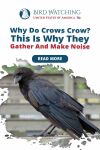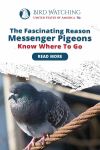
What’s This Post About?
Most of us are well aware of what a crow caw sounds like. This is because crows are noisy birds, and if they are present nearby, they will mark their presence through their caws. However, what seems like noise to us, though, is clever communication among the crow community.
Crows are well-known for their intelligence. They can make various noises, but the caw is the most common and distinctive method they use to engage with their companions, particularly when separated.
There are multiple reasons why crows caw. It is their way of telling their companions if there are predators or dangers nearby. They caw to alert the other crows if they see a large bird or a fellow crow dead. Caws can also be used to gather their friends and relatives for feasting upon finding a food source.

Reasons Why Crows Caw?
There are caws for certain occasions, like departure cries, noises made during a chase, or sounds made during courtship.
When a species has as many skills as the crow, it may change its natural sound to interact or express itself. The question is if we know what happens when crows caw and which messages are conveyed along with it.

We must also consider the body language that follows the noise and the volume and frequency of the cawing. For example, crows may use their beaks to produce various noises, and they can even use objects to attract the attention of their peers.
To know the reason, try to judge the surrounding area for other clues such as animals, humans, nests, or food.
1. Meeting Relatives
The most apparent reason behind crows cawing is essential interaction with their friends and relatives. While still audible, these caws are not as high-pitched as the others. You will hear these sounds in daily life from trees, telephone poles, or anywhere the crow community has gathered.
The crow has been shown to have great recollection for its mates, remembering them after intervals of up to 3 years. When a crow encounters other birds, it will caw differently depending on whether they are relatives, a bunch of young adults, or foes.
The song of a crow is unique to its social circle. According to investigations of captive birds, each group develops specific sound components that form a type of dialect that crows use to identify one another.
2. Mating

This bird’s mating behaviors take place on the ground. First, the male bird makes a courting display by fluffing its plumage and approaching the female. Then he extends his feathers and tail partly and bows periodically while singing a short rattling song.
The mating caws are distinct from all other caws. Crows, unlike many other birds, do not caw loudly to lure mates from afar. Instead, they use a rich combination of quiet cooling, rattling, growling, bowing motions, and reciprocal snuggling to sing gently at close distance courting.
DID YOU KNOW?
These calls are least heard because crows mate for life, and the courting process happens just the first time.
3. Protecting Their Territories

If an enemy crow gets too close to a nest, it will engage in intensive chasing activity, with loud, angry vocalizations, as it chases intruders across the sky. While solid and aggressive demonstrations are most prevalent during the spring nesting season, they can be seen in various ways throughout the year.
During spring, the battles between the crows are most intense. They may be communal birds, but at this time, they become fierce and aggressive as they have to fight for good nesting spots. You will be able to hear these caws from a great distance.
There will be extreme cawing when crows find essential food items, such as fish or meat. Food battles between groups of crows sometimes resemble nest defense, but if you look closely, you can often see food in the leading crow’s beak.
DID YOU KNOW?
Crows often rob from eagles or ospreys near lakes and rivers, as well as in towns where there are many possibilities for scavenging.
4. On Seeing Large and Unknown Birds
One of the reasons crows caw is to send out a specific signal to species they come into contact with. Crows produce a brief, low-pitched caw when they sense the presence of other aggressive individuals or unidentified birds. This is interpreted by researchers as an effort to appear more prominent and dangerous.
5. To Warn Other Crows of Danger

Crows will caw when they see any kind of danger, be it human, predator, or parasite animals looking to dump their eggs into their nests. These caws will be the most intense and will keep getting louder as more crows join the “murder” to intimidate the potential threat.
All the nearby crows will gather around and begin to make noise. This defense strategy works excellent for species like eagles which are much larger than a crow. A singular crow cannot fight such predators alone, and thus their strength lies in number.
Another reason why crows caw a lot in this scenario is that they want to inform everyone around them that there is a danger lurking around in the corner. This ensures that everyone is cautious and helps the young learn which animals to fear.
DID YOU KNOW?
Even after the predator bird flees the area, the crows will pursue the owl or hawk for a bit longer, ensuring that it has flown a considerable distance.
6. At the Sight of a Dead Crow
Crows also caw to alert their fellow crows of impending danger, especially when encountering a dead crow. In such a situation, the scared crow will raise the alarm with a series of loud, even harsh caws.
They will depart the location after making a sort of funeral-like sound collectively. Crows may take many days to return to where one was discovered dead since they believe the region has become harmful to them.
7. Find, Show or Gain Access to Food
Crows’ caws have evolved to communicate ‘pleasant’ appearances, such as a set of individuals who leave food in the same spot regularly. As established before, crows have an excellent memory and are very social. If they find a food source, they will caw and invite their mates to it.
Crows convey in a non-threatening manner that they are present and eager to engage. The most typical pattern of crows cawing, for this reason, is a burst of 3-5 caws, a break, and then a few more caws. Humans can form trusting relationships with crows by listening and responding to these caws.

Crows are immensely intelligent beings. They do not scare easy by other animals and also know when to use them to their advantage. Sometimes they caw to direct larger scavengers to bodies and persuade them to open them up. After the larger animals leave, the crows feast on the leftovers.
8. Outside a Window
When a crow caws on a window, several people become concerned. After all, the shadowy bird is the least appealing sight. Crows have a commanding presence, so you get the impression that they’re accompanied by a powerful force whenever you see them.
However, if you put the superstitions aside, a crow will caw or peck at windows for many reasons. They might be seeking food, but the most prevalent explanation is because they are afraid of their own image reflecting on the window surface. This is especially true if they appear angry or continue to caw without stopping.
When Do Crows Stop Cawing?
People frequently assume these birds are sick or injured, although their silent behavior is typical for post-breeding.
During summers, crows are still territorial, but it manifests itself differently. Because fledglings spend so much time on the ground, you’ll observe that instead of being loud and provocative, the adults may become oddly silent when it comes to where the young are housed.
They do not want to draw unnecessary attention towards their children, who still can’t fly independently. When they are on the ground, the fledglings are frequently deafeningly quiet.
After the young birds eventually join the adults, usually during mid-September, things in the neighborhood became a lot noisy.
How To Recognize the Type of Vocalization?

The best method to identify the causes of crow caws is knowing the vocalizations connected with various activities. Territorial speech patterns, for example, are pretty prevalent, and the noise stands out in a setting, even to those who are unfamiliar with birds.
Crows prefer to vocalize in brief, calm spurts intermingled with rest intervals and hearing when comfortable. Usually, it’s just one bird making simple caws as the others graze nearby or leisurely explore the area.
There is nothing to worry about when you just hear a few caws from one crow followed by brief intervals of quietness, and it suggests casual conversation amongst the crows.
When territorial cries are heard nearby, the vocalizations grow louder, more intense, and frequently originate from numerous birds. If you hear multiple crows cawing simultaneously, you can expect territorial or food battles going on.
To tell whether the battle is about food or nests, judge the birds and their flight path. The chasers will return home after the invading crows have left the skies. The pursuit will go on until someone manages to win the meal when it comes to food battles.
DID YOU KNOW?
Territorial calls are different from alarm calls? Alarm calls are for when predators are around, and crows are warning or gathering the birds!
What Does Crow Cawing Signify?
Crows have been associated with sorcery, black magic, superstition, and tragedy owing to their secretive demeanor and black feathers.
It’s a widespread belief that if a crow chases you and caws at you incredibly late at night, you’ll have bad luck or die. However, if a crow caws at you first thing in the morning, you’ve avoided tragedy and are on your way to new possibilities.

Here are a few superstitions that are linked to the number of crows cawing at you:
- One crow cawing is said to indicate ill luck and impending disaster.
- The sound of two crows cawing is thought to represent good fortune, harmony, and good news.
- You will be rewarded with excellent health if you see three crows cawing.
- Four crows cawing indicates that you will soon be blessed with riches, fortune, and success.
- Five crows cawing is a sign of impending sickness and poor health.
- When a big flock of crows caws, it is thought that death will occur.

Keep Reading!
You hear different caws of varying volume and intensity all day. This almost never-ending noise has multiple reasons behind it. Crows use their sound to signal to their community about potential dangers or potential food sources.
Sometimes when these caws get aggressive, know that there must be territorial battles going on, and it is best to steer clear of the area.
Now that you know why crows caw and the superstitions behind it, read more about people’s beliefs about seeing crows, especially seeing 3 crows together.
What Does Seeing 3 Crows (Or Ravens) Really Mean?
Did you recently see a crow and were left wondering what it means? Read ahead to find out what seeing crows generally means.

By David A. Swanson
Bird Watching USA
My name is David and I'm the the founder of Bird Watching USA! I started Bird Watching with My father-in-law many years ago, and I've become an addict to watching these beautiful creatures. I've learnt so much over about bird watching over the years that I want to share with the world everything I know about them!

David A. Swanson
Bird Watching USA
My name is David and I'm the the founder of Bird Watching USA! I started Bird Watching with My father-in-law many years ago, and I've become an addict to watching these beautiful creatures. I've learnt so much over about bird watching over the years that I want to share with the world everything I know about them!









